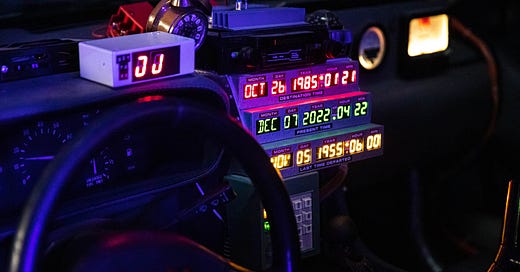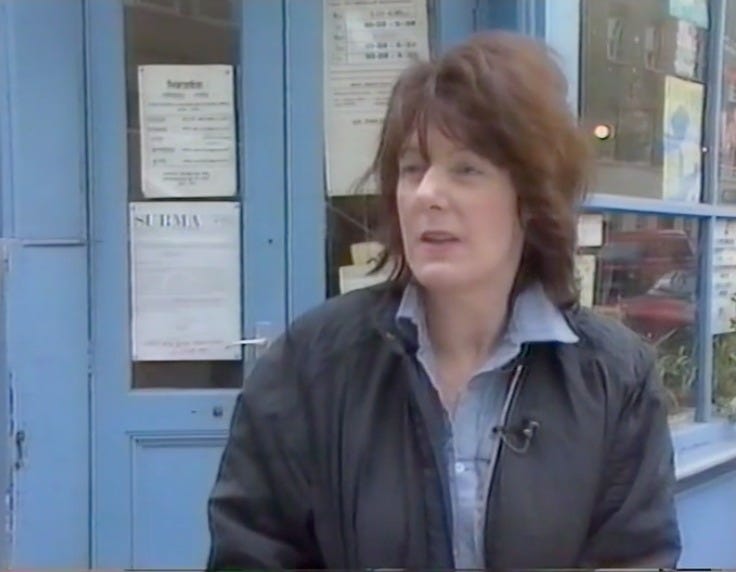Fragment 37: The Life & Times of a Social Experiment
In search of the still point of the turning world. A.k.a. a load of old gossip.
Here are two events from 1985:
One: the movie Back to the Future starring Michael J. Fox and Christopher Lloyd, and directed by Robert Zemeckis, was released. (The above image from Hethers / Shutterstock.com is from the film.)
Two: I moved into an apartment in Fitzrovia in central London.
The Fine Readers of Aargh!: Is there any conceivable way whereby those two entirely arbitrary facts may be connected?
Myself: I believe so.
The Fine Readers of Aargh!: Go on then …
Myself: Well, you may recall that the movie plays with time. Marty McFly (Michael J. Fox) uses the time machine invented by Dr Emmett Brown (Christopher Lloyd), integral with a DeLorean automobile, to go back in time from 1985 to 1955.
The Fine Readers of Aargh!: Of course. Who could forget the wonderful scene where Marty performs Chuck Berry’s ‘Johnny B. Goode’, introducing the kids to 1950s rock ‘n’ roll? But how has that got anything whatsoever to do with you moving home?
Myself: Well, I’m interested in the idea of playing with time. Past. Now. Future. Are they separate or are they not only connected but, ultimately, all the same?
The Fine Readers of Aargh!: If you don’t mind our saying so, that sounds like a very tenuous, spurious and dubious connection and comment.
Myself: Well, let’s see. I’d like to take you back from 2025 to 1985.
The Fine Readers of Aargh!: Would you, now? Well, it better be worthwhile. Yesterday. Today. Tomorrow. Whatever next!
Myself: Perhaps the day after tomorrow?
The Fine Readers of Aargh!: Cheeky! Don’t push your luck!
The previous fragment in this autobiographical strand was published at the end of 2024. In the world of social media that is a very, very, very long time ago. During the four-month break between then and Now a handful of people have said that they’d like the strand to continue and I’ve, so to speak, nodded noncommittally.
Truth is I felt that I needed the break. But, now, it feels right to carry on. That’s partly because of your requests for me to continue (for which many thanks), but also because I’ve been pondering the effect of the passage of Time upon one’s life.
I mean that in a fairly straightforward sense: when we are young there is only Now; but the older we get the more the continuum of Past-Now-Future reveals itself. (This thought can be extrapolated to conclude that time is actually an illusion, but I’ll keep that for a separate post.)
When we are young, Now is all there is; there is no other point of reference. As kids we do, of course, learn about the Past … but it’s all just a story at that point. Or maybe that’s just me?
Later, however, the continuum of Time comes into view and, speaking from my own experience, gains in perceived importance as Time goes on. Consequently, at some point one becomes aware of it. For me, that seems to have happened around the time of my fortieth birthday and when I moved into the apartment in London’s Fitzroy Street. Which is to say, 1985.
The home move, as you may recall from an earlier fragment, was courtesy of the kindness of my friend John Stadden who was the principal of advertising and marketing agency Stadden Hughes. John had helped solve the critical issue of access to my daughter while I was trying to work out how best to resolve the calamity of my second marriage.
Ultimately, I’d decided that the only way was out, as outlined here. So, there I was, newly installed in my apartment on the first floor of the Robert Adam-designed Georgian building.
The apartment was small. A property agent would, I suspect, have described it as compact or, even, bijou. One floor of the house, segmented to provide a small kitchen, a small bathroom and two living rooms.
The saving grace was that, being the first floor above ground level in a classic Georgian design, the ceiling was high, nearly four meters. This meant that, within a reasonably short time, I was able to construct a ‘flying’ bed platform in the room furthest from the street, effectively adding an extra room.
So, what was the view through the west-facing, four-meter high front windows that looked out onto the street?
To the left was a view of the north side of Fitzroy Square with its grassy area and mature plane trees surrounded by railings and well-kept pedestrian area.
Directly opposite where there was a break in the row of housing was an attractive tree. This was nature’s way of concealing the fact that the break had been created some forty-something years earlier by a Second World War bomb. Some time later, the site was cleared and a new building created to reinstate something more like the situation that must have existed before the Luftwaffe struck.
Opposite but to the right were more long-standing buildings, mostly divided into apartments. At the first of these - No. 39 Fitzroy Street - lived a couple of people who were to become firm friends.
In the basement apartment was Geoffrey Lacey. Geoff died in 2000 and, based on my rather hazy recollection of the lunch that we had in my apartment on the occasion of his seventy-fifth birthday, he must have been born in the mid-1920s. By profession he was a dentist and a very good one, too.
His private life was somewhat chaotic in that, although he was gay, his partner, Ken, was married … to a woman. The inevitable upshot of this arrangement was a fair dollop of emotional turmoil.
Nonetheless, Geoff had a wicked sense of humour and could be an absolute hoot. His recollections of the past were often riveting. As a long-standing resident of Fitzrovia, he would talk, for example, about drinking in the Fitzroy Tavern with Dylan Thomas (1914-1953). Well, I say drinking with but drinking alongside might be a more accurate way to put it.
As Geoff described it, Dylan Thomas would buy seventeen bottles of Worthington India Pale Ale, all at once, all lined up on the bar, and steadily progress his way through the lot. Seventeen bottles! Why seventeen? No idea.
Two floors above Geoff’s basement apartment, on a level with my own new home across the road, lived Judy Dainton (nee Thomas) (1943-2022). With a fine intelligence and fierce social conscience Judy truly was a force of nature.
She was also one hell of a drinker. In those days, The Smugglers Tavern in Warren Street, the public house just around the corner from both of our homes, which at the time was run by an Irish couple, Danny and Teresa, was very much a central point in our neighbourhood. Judy and I sometimes met there. Mind you, we didn’t necessarily stay there.
Fitzrovia is to the north of Oxford Street and contiguous with Soho to the south so there was certainly no shortage of drinking establishments. But, back then, pubs opened at 11.00 a.m. and closed at 3.00 p.m., then reopened at 6.30 p.m. to close again at 11.00 p.m. Which left open the question of where one might get a drink after 11.00 p.m. or where one might position oneself prior to 11.00 p.m. so as to be just a quick stumble away from a late-night watering hole.
The imperative sometimes took us south towards Oxford Street, perhaps to Helen’s Club - Helen of Troy, no less - in Hanway Place, which was often packed until 3.00 a.m.
Or across Oxford Street to The Colony Room on Dean Street. The Colony became famous in the days of its founder, Muriel Belcher, but she sadly died in 1979. By all accounts she was one helluva woman.
It was George Melly who summed it up at her funeral. He said, “I know this is a sad occasion but I just want you all to imagine the look on St Peter’s face when she arrives at the Pearly Gates, bangs on the door and shouts ‘Let me in, Clara!’”1
So, when Judy introduced me to The Colony in the 1980s, Muriel was talked about a great deal was not there in person. On occasion, we went a little further still, to Gerrard Street and the heart of Chinatown. It was here that I realized the depth of Judy’s passion for social justice.
I've just taken down from my bookshelf a copy of The Complete Works of Geoffrey Chaucer. Inscribed inside the cover with ‘Judith Thomas, New Hall’ it was a present to me from her.
Judy graduated from New Hall, Cambridge (now Murray Edwards College) and, for a time, worked in journalism at The Lady. She became involved in local politics and, as I understand it, working with Camden Council, helped the London Chinese community to become established. On a couple of occasions we ventured into Chinatown where Judy was quickly recognized and clearly held in huge esteem.
Photo: Judy campaigning for more social housing
In the 1970s, Judy was one of a small group of concerned people who launched the Fitzrovia Neighbourhood Association. Her obituary in the Camden New Journal starts thus:
A COMMUNITY activist who devoted her life to battling double-dealing developers and unscrupulous landlords has been remembered this week as a likeable and loyal character “who you’d want in your pub quiz team”.2
Oh, by the way, Judy used to call the homosexual dentist, Geoff, ‘the tooth fairy’. And Geoff would giggle with mirth. Life was definitely better before the suffocating fumes of political correctness stifled our discourse.
Myself: There we are. I’ll take the story up again in the next fragment.
The Fine Readers of Aargh! (feigning disinterest): It’s a load of old scuttlebutt!
Myself: So it is. Shall I stop, then?
The Fine Readers of Aargh! (anxiously): Oh, no, no - you’d better get it off your chest.
Thanks for reading.
Sandy Fawkes. The French: A Personal History (1993)
https://www.camdennewjournal.co.uk/article/farewell-to-judy-dainton-the-scourge-of-the-central-london-developers






"... when we are young there is only Now; but the older we get the more the continuum of Past-Now-Future reveals itself." So true!
What a fine sketch of a time and place and some of the people who crossed your path.
And ‘the tooth fairy’ is a hilarious pet name :-)